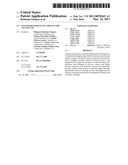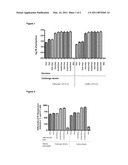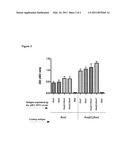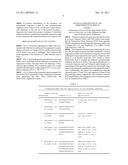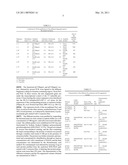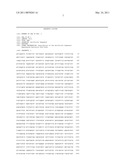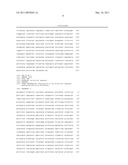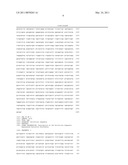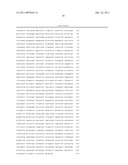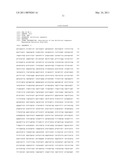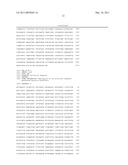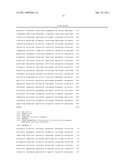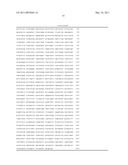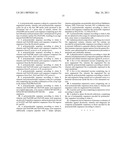Patent application title: ENGINEERED PERTACTIN VARIANTS FOR VACCINE USE
Inventors:
Diógenes Quintana Vázquez (Ciudad De La Habana, CU)
Diógenes Quintana Vázquez (Ciudad De La Habana, CU)
Tamara Menendez Medina (Ciudad Habana, CU)
Anabel Álvarez Acosta (Ciudad De La Habana, CU)
Anabel Álvarez Acosta (Ciudad De La Habana, CU)
Yoelys Cruz Leal (Ciudad De La Habana, CU)
Gerardo Enrique Guillen Nieto (Ciudad De La Habana, CU)
IPC8 Class: AA61K3910FI
USPC Class:
4242541
Class name: Bacterium or component thereof or substance produced by said bacterium (e.g., legionella, borrelia, anaplasma, shigella, etc.) bordetella (e.g., bordetella bronchiseptica, etc.) bordetella pertussis
Publication date: 2011-03-24
Patent application number: 20110070265
Abstract:
The present invention is related with the field of Biomedicine. It
comprises the engineering of the Pertactin protein (Prn) and using it as
part of bacterial vaccines, and more precisely, as part of acellular
vaccines against Bordetella pertusis. The engineered Prn molecules
comprise on their structure polimorfisms from different B. pertussis
strains, and induce immune responses with protective capacity and
opsonophagocytic activity when assayed as vaccines, higher than that
generated by other pre-existing vaccines. The engineered Prn variants of
the present invention are applicable in human and veterinary medicine.Claims:
1. A polynucleotidic sequence coding for a pertactin (Prn) engineered
protein, wherein said polynucleotidic sequence codes for up to the first
300 amino acids proximal to the N-terminal end of a given type of
natural, mature Prn (PrnX300) and an amino acid sequence comprising up to
the last 620 amino acids proximal to the C-terminal end of a given type
of natural, mature Prn (PrnY620), resulting in an engineered
PrnX300-PrnY620 pertactin.
2. A polynucleotidic sequence according to claim 1, wherein said PrnX300 amino acid sequence comprises Prn sequences from the Bordetella genera.
3. A polynucleotidic sequence according to claim 2, wherein said PrnX300 amino acid sequence comprises Prn sequences from B. pertussis or B. parapertussis.
4. A polynucleotidic sequence according to claim 3, wherein said PrnX300 amino acid sequence comprises Prn sequences from Prn1, Prn2 and Prn3 of B. pertussis.
5. A polynucleotidic sequence according to claim 1, wherein said PrnY620 amino acid sequence comprises Prn sequences from the Bordetella genera.
6. A polynucleotidic sequence according to claim 5, wherein said PrnY620 amino acid sequence comprises Prn sequences from B. pertussis or B. parapertussis.
7. A polynucleotidic sequence according to claim 3, wherein said PrnY620 amino acid sequence comprises Prn sequences from Prn1, Prn2 and Prn3 of B. pertussis.
8. A polynucleotidic sequence according to claim 1, wherein said polynucleotidic sequence codes for a polypeptide comprising any possible combination of Prn of any type in the format PrnX300-PrnY620.
9. A polynucleotidic sequence according to claim 1, wherein said PrnX300 and PrnY620 amino acid sequences are coupled adjacently, or by means of IDNATWVMTDN or IDNATWVMTDNIDNATWVMTDN amino acid sequences.
10. A polynucleotidic sequence according to claim 1, wherein said PrnX300 and PrnY620 amino acid sequences are devoid of repetitive sequences, and more precisely, devoid of GGXXP and PQP repetitive sequences from Prn regions R1 and R2.
11. A polynucleotidic sequence according to claim 1, wherein said PrnX300 and PrnY620 amino acid sequences additionally comprise peptides with T helper epitopes, wherein said peptides are preferably derived from Diphtheria, Tetanus, HBV, Poliovirus, Vaccinia, HIV or Influenza virus.
12. A polynucleotidic sequence according to claim 1, wherein said sequence comprises the nucleotidic sequences identified as SEQ ID Nr. 1 to SEQ ID Nr. 6.
13. A polynucleotidic sequence according to claim 1, that has an optimized codon usage for optimal expression in bacteria, yeast, insect or mammalian cells.
14. A pharmaceutical composition comprising one or more Prn engineered variants, wherein said Prn variants are encoded by polynucleotidic sequences according to claim 1, in amounts sufficient to generate effective humoral and cellular immune responses against species from the genera Bordetella, once administered by an immunization procedure to mammals and, preferably, humans.
15. A pharmaceutical composition according to claim 14, wherein said pharmaceutical composition generates effective humoral and cellular immune responses against B. pertussis.
16. A live or live attenuated vaccine comprising one or more engineered Prn, wherein the engineered Prn are encoded by polynucleotidic sequences according to claim 1, wherein said engineered Prn is preferably expressed in the outer membrane.
17. A live or live attenuated vaccine comprising one or more engineered Prn, wherein the engineered Prn are encoded by polynucleotidic sequences according to claim 1, the said sequences being carried out in a plasmid vector or a bacterial chromosome inside the live or live attenuated vaccine.
18. A mammalian expression vector comprising one or more polynucleotidic sequences from claim 1, wherein said sequences codes for engineered Prn molecules.
19. A nucleic acid vaccine comprising an expression vector according to claim 18.
20. A method to detect Bordetella infections, comprising the use of polypeptidic sequences encoded by polunucleotidic sequences according to claim 1.
21. A diagnostic kit for detection of presence or absence of antibodies against Bordetella, wherein said diagnostic kit comprises polypeptidic sequences as those encoded by the polynucleotidic sequences according to claim 1.
Description:
TECHNICAL FIELD
[0001]The present invention is related with the field of Biomedicine. It comprises the engineering of the Pertactin protein (Prn) and using it as part of bacterial vaccines, and more precisely, as part of acellular vaccines against Bordetella pertusis. The engineered Prn molecules comprise on their structure polimorfisms from different B. pertussis strains, and induce immune responses with increased protective capacity and opsonophagocytic activity when assayed as vaccines, higher than that generated by other pre-existing vaccines.
BACKGROUND OF THE INVENTION
[0002]Whooping Cough or Pertussis is an acute, highly infectious respiratory disease caused by the Bordetella pertussis bacterium, a microorrganism formerly isolated by Bordet and Gengou in 1906 [Bordet, J. and O. Gengou. Ann Inst Pasteur (Paris), 1906. 20: p. 731-41]. Recently, the annual morbidity of infections throughout the world was estimated in 48.5 millions. The disease is particularly severe in children with less than six months of age, with 90% of the casualties being associated to this ethareal group (300,000-400,000) [Crowcroft, N. S., et al. Lancet Infect Dis, 2003. 3(7): p. 413-8].
[0003]Several vaccines are available against B. pertussis, distributed in two main groups according to their type: cellular vaccines, and, more recently, acellular vaccines. Vaccination has dramatically decreased the incidence of the disease, moving it from children towards teenager and adult populations. Several studies have shown teenagers as the major reservoir for B. pertussis and the main source for spreading of this disease among partially protected children. Therefore, whooping cough remains as an unsolved health problem, demanding the development of new vaccines for a better control of the epidemics and re-emergent outbreaks, and possibly to eradicate this disease in endemic regions [Cherry, J. D. Pediatrics, 2005. 115(5): p. 1422-7; Singh, M. and K. Lingappan, Chest, 2006. 130(5): p. 1547-53]. The Bordetella genera includes nine species, four of them being associated to infections in mammals (B. holmesii, B. bronchiseptica, B. parapertussis and B. pertussis), the last two being responsible for infections in humans [Mattoo, S., et al. Front Biosci, 2001. 6: p. E168-86]. Most of their virulence factors are regulated at transcriptional level by a two-components system denominated BvgA/S (Bordetella virulence genes Activator/Sensor) [Stibitz, S., et al. Nature, 1989. 338(6212): p. 266-9]. Among them, the most relevant factors are the Pertussis toxins (PT), the tracheal colonization factor, adenylate cyclase; and adhesins filamentous Phytohemagglutinin (PHA), Fimbriae (Fim) and Pertactin (Prn), the latter being the focus of the present invention.
[0004]Prn is an outer membrane protein belonging to the family of type V autotransporter proteins. It is characterized by catalyzing its own transportation through the bacterial outer membrane [Henderson, I.R. Trends Microbiol, 2000. 8(12): p. 534-5]. The mature Prn is a protein of 68 kDa in B. bronchiseptica [Henderson, I.R. Infect Immun, 2001. 69(3): p. 1231-43.], 69 kDa in B. pertussis [Charles, I. G., et al. Proc Natl Acad Sci USA, 1989. 86(10): p. 3554-8] and 70 kDa in B. parapertussis [Li, L. J., et al. Mol Microbiol, 1991. 5(2): p. 409-17], respectively. Its structure consists on 16 paralel strands forming a β helix and a transversal section in V form [Emsley, P., et al. Nature, 1996. 381(6577): p. 90-2.]. Numerous loops protrude from this helicoidal core. One of them is the Arg-Gly-Asp triplete (RGD), a motif associated to tissue adherence [Leininger, E., et al. Infect Immun, 1992. 60(6): p. 2380-5; Emsley, P., et al. Nature, 1996. 381(6577): p. 90-2]. The presence of this motif and numerous proline-rich regions are related to Prn functions during adhesion. Experiments have shown that the Prn can mediate adhesion to cells of the respiratory epithelium [Everest, P., et al. Microbiology, 1996. 142 (Pt 11): p. 3261-8]. Nevertheless, assays on the inhibition by human sera of B. pertussis adhesion to A549 cultured cells (alveolar human epithelium) did not evidence Prn as a crucial element during that process under the tested conditions [Rodriguez, M. E., et al. FEMS Immunol Med Microbiol, 2006. 46(1): p. 39-47].
[0005]The Prn protein is part of acellular vaccines composed of three or more components. Acellualr vaccines can be composed of: 1) one component of PT, 2) two components: PT and PHA, 3) three components: PT, PHA and Prn, and 4) five components, including the three components previously mentioned and also the Fimbriae 2 (Fim2) and Fimbriae 3 (Fim3) proteins. In humans, the levels of the anti-Prn, anti-Fim2 and anti-PT antibodies correlate with protection levels against the disease [Cherry, J. D., et al. Vaccine, 1998. 16(20): p. 1901-6; Storsaeter, J., et al. Vaccine, 2003. 21(25-26): p. 3542-9].
[0006]The active immunization with Prn of B. pertussis and B. bronchiseptica induces a specific antibody response against Prn, confering protection in different animal models [Charles, I. G., et al. Eur J Immunol, 1991. 21(5): p. 1147-53; Roberts, M., et al. Vaccine, 1992. 10(1): p. 43-8]. Similarly, the passive administration of anti-Prn monoclonal antibodies (MAbs) protected mice in the model of respiratory challenge [King, A. J., et al. Microbiology, 2001. 147(Pt 11): p. 2885-95]. Protection levels in mice subjected to the intranasal challenge assay (INCA) were increased by adding Prn to vaccines containing PT and PHA [Guiso, N., et al. Vaccine, 1999. 17(19): p. 2366-76]. It has been recently shown that Prn is the only component of acellular vaccines which generates an antibody response of such a level that correlates to the opsonophagocytic activity [Hellwig, S. M., et al. J Infect Dis, 2003. 188(5): p. 738-42]. In spite of efficacious vaccines and the well established vaccination programs available, whooping cough is still endemic in regions of America, Europe and Asia, being considered as a re-emergent disease [Raguckas, S. E., et al. Pharmacotherapy, 2007. 27(1): p. 41-52]. One of the hypotheses trying to explain this phenomenon is based on the loss of efficacy, due to appearance of resistant strains [Mooi, F. R et al. Emerg Infect Dis, 2001. 7(3 Suppl): p. 526-8]. Prn is one of the most polymorphic proteins in B. pertussis. It contains two variable regions designated as region 1 (R1) and 2 (R2), respectively, with repetitive amino acid sequences rich in proline Gly-Gly-X-X-Pro (GGXXP) and Pro-Gln-Pro (PQP) motifs. The R1 region is located in the protruding loop proximal to the aminoterminal sequence (N-terminal) and near to the RGD motif, while the R2 region is located near to the carboxyl terminal end (C-terminal) [Hijnen, M., et al. Infect Immun, 2004. 72(7): p. 3716-23]. Up to 12 different variants of Prn (Prn1, Prn2, Prn3 . . . Prn12) have been identified in B. pertussis, as shown in the database of the National Center for Biotechnology Information of the United Staes of America (NCBI). Strains bearing the Prn1, Prn2 and Prn3 are distributed worldwide. Numerous strain characterization studies, either retrospective or of strains currently circulating, were carried out in American, European, Asian and Australian regions and showed a tendency towards a progressive persistence of Prn2 strains over Prn1 strains, the Prn2 strains predominating in most of the countries studied [Mooi, F. R., et al. Infect Immun, 1998. 66(2): p. 670-5; Cassiday, P et al. J Infect Dis, 2000. 182(5): p. 1402-8; Weber, C. et al. J Clin Microbiol, 2001. 39(12): p. 4396-403; Hallander, H. O., et al. J Clin Microbiol, 2005. 43(6): p. 2856-65; van Amersfoorth, S. C., et al. J Clin Microbiol, 2005. 43(6): p. 2837-43; Byrne, S, et al. BMC Infect Dis, 2006. 6: p. 53].
[0007]Current differences in the amino acid sequence of Prn between cellular (DTPc) or acellular (DPTa) vaccines and circulating strains is one of the factors supporting the hypothesis of the efficacy loss of vaccines available, due to the appearance of new strains. Studies in populations vaccinated with DPTc or DTPa, and non-vaccinated populations, in Netherlands and Italy indicated that these types of vaccines protect better against circulating strains similar to the vaccine strain [Mooi, F. R., et al. Infect Immun, 1998. 66(2): p. 670-5; Mastrantonio, P., et al. Microbiology, 1999. 145 (Pt 8): p. 2069-75]. In agreement with these findings, it was shown in the mice model that vaccination with DPTc differentially protects against strains bearing Prn1 and Prn2, indicating that changes in the Prn R1 region can confer resistance levels [King, A. J., et al. Microbiology, 2001. 147(Pt 11): p. 2885-95]. However, massive studies stratifying B. pertussis strains according to country of origin, vaccination status, and type of vaccines (DPTc and DPTa), did not show significant differences in the frequencies of prn, ptxC, ptxA or tcfA2 alleles for circulating strains and vaccination programs [van Amersfoorth, S. C., et al. J Clin Microbiol, 2005. 43(6): p. 2837-43]. The high prevalence of Prn2 strains in many countries is indicative of the favored transmission of these strains by means still unraveled, although the findings mentioned above hardly link the origin of new variants to vaccination. Remarkably, in the above mentioned study [van Amersfoorth, S. C., et al. J Clin Microbiol, 2005. 43(6): p. 2837-43], the three clinically isolated strains bearing allelles similar to that of the vaccines used were found only in non-vaccinated children. Either casual or not, it suggests that Prn1 strains are favored in niches devoid of specific immunity. On the other hand, the recent identification of a phage infecting Bordetella (BPP-1) by using Prn as primary receptor, suggested that variations in this protein might be triggered by selective pressures other than those imposed by the immune system [Liu, M., et al. Science, 2002. 295(5562): p. 2091-4]. The possible influences of both phenomena, together with other unknown factors leading to harmonized variations in B. pertussis, are not excluded.
[0008]The evolution of Pertussis epidemiology has been simulated by a mathematical model, integrating the incidence of the disease and the pathogen's transmission independently [Aguas, R., et al. Lancet Infect Dis, 2006. 6(2): p. 112-7]. This model predicts that regular boosting doses would not be capable of eliminating the severity grades of the disease, observed in current epidemics. It is highly probable that this should be caused by the short lifespan of the protection conferred by the available acellular vaccines (4-12 years), and also the variability of the immune response and the different types of vaccines. This model predicts as the most optimistic scenario that where vaccines could generate an immunity superior to the natural one, a paradigm still unreached by the cellular and acellular vaccines available.
[0009]The main purpose of the present invention resides on the contribution to develop more efficacious acellular vaccines against Whooping Cough. The main work preceding the present invention were based on administering immunogenic preparations obtained by mixing Prn proteins (Nicole Guiso et al., WO 01/90143 A2 y US 2006/0008474 A1) or synthetic peptides of the Prn R1 region (Frederik Mooi et al., WO 02/00695 A2). Therefore, the development of more efficacious acellular vaccines is an important problem to prevent Whooping Cough.
DETAILED DESCRIPTION OF THE INVENTION
[0010]This invention contributes to solve the above mentioned problems, and comprises the engineering of the prnA gene, coding for the outer membrane protein of B. pertussis denominated Pertactin (Prn). This invention suffices the needs evidenced in the state of the art, making possible obtaining different variants of engineered Prn, in such a way that they comprise in their structure two different polymorphic domains of the Prn R1 region. The versatility of the invention also covers the engineering of new Prn molecules, additionally comprising three or more different polymorphic domains of the Prn R1 region.
[0011]Is subject of the present invention a polynucleotidic sequence coding for an engineered Prn protein, wherein said protein comprises up to the first 300 amino acids proximal to the N-terminal end of a natural, mature Prn of a given type (PrnX300), and an aminoacidic sequence comprising up to 620 amino acids proximal to the C-terminal end of a natural, mature Prn of given type (PrnY620), resulting in an engineered PrnX300-PrnY620Prn protein.
[0012]In the context of the present invention, the term `engineered Prn` refers to a protein resulting from coupling, adjacently or not, of a fragment comprising up to the first 300 amino acids proximal to the N-terminal end of a given natural, mature Prn protein, to another fragment comprising the last 620 amino acids proximal to the C-terminal end of a natural, mature Prn protein.
[0013]The new Prn engineered variants are obtained by molecular mutagenesis, by adjacent coupling of sequences comprising up to the first 300 amino acids proximal to the N-terminal end of a natural, mature Prn of a given type, to sequences comprising up to the last 620 amino acids proximal to the C-terminal end of a natural, mature Prn of a given type. The new variants of engineered Prn comprise sequences from the same or different type of Prn in a single molecule, without affecting the protective immune response.
[0014]In a preferred embodiment of the present invention, different variants of Prn engineered variants are obtained, encoded by the nucleic acid sequences identified as SEQ ID Nr. 1-SEQ ID Nr. 6. Highly significantly protection levels and opsonophagocytic activities were obtained by immunizing mice with the different variants of engineered Prn, higher than those obtained with natural Prn molecules formulated alone or combined in mixes. The immune response generated with the engineered Prn was equally effective against strains expressing different types of Prn.
[0015]In a preferred embodiment of the present invention, the fragment comprising the first 300 amino acids proximal to the N-terminal end of a natural, mature Prn of a given type, named PrnX300, corresponds to Prn from the genera Bordetella. In another preferred embodiment of the present invention, this fragment corresponds to Prn molecules from B. pertussis or B. parapertussis, preferably Prn1, Prn2 and Prn3 variants of B. pertussis.
[0016]In a preferred embodiment of the invention, the las 620 amino acids proximal to the C-terminal end of a natural, mature Prn of a given type, named PrnY620, corresponds to Prn from the genera Bordetella. In another preferred embodiment of the present invention, this fragment corresponds to Prn molecules from B. pertussis or B. parapertussis, preferably Prn1, Prn2 and Prn3 variants of B. pertussis.
[0017]The polynucleotidic sequence of the present invention codes for a polypeptidic sequence comprising any possible combination of Prn types in the format PrnX300-PrnY620.
[0018]The amino acid sequences PrnX300 and PrnY620 coded by the polynucleotide sequence of the present invention are adjacently coupled, or by using the amino acid sequences IDNATWVMTDN or IDNATWVMTDNIDNATWVMTDN.
[0019]In the present invention, the amino acid sequences PrnX300 and PrnY620 can be devoid of repetitive sequences, preferably of GGXXP and PQP sequences of the R1 and R2 regions. The evidences supporting this design are the following: the Region 1 (R1), comprising the repetitive sequence GGXXP is weakly recognized by human and rabbit sera, indicating that it is not an immunodominant region [Hijnen, M., F. R. Mooi, et al. (2004). Infect Immun 72(7): 3716-23]. On the other hand, recent work reported Prn mutants where the repetitive GGXXP and PQP sequences or regions containing these sequences were deleted. GGXXP deletions did not affect the physicochemical properties of the mutant Prn molecules obtained, as evidenced in the similar methods used for expression and purification of mutant and non-mutant Prn proteins [Hijnen, M., P. G. van Gageldonk, et al. (2005). Protein Expr Purif 41(1): 106-12]. Similarly, deletions of the GGXXP sequences did not significantly affected structural properties, since Prn molecules mutated in R1 were well recognized by MAbs generated against conformational epitopes in natural Prn molecules, and also not recognized by anti-GGXXP MAbs directed against linear GGXXP epitopes. Additionally, it was observed that certain mutations inside R1 can enhance the binding capacity to certain MAbs against conformational epitopes. Finally, there were evidences indicating that R1 (GGXXP) and R2 (PQP) form a single epitope [Hijnen, M., R. de Voer, et al. (2007). Vaccine 25(31): 5902-14]
[0020]In another preferred embodiment of the present invention, the said polynucleotidic sequence codes for an engineered Prn, wherein said amino acid PrnX300 and PrnY620 sequences comprise heterologous peptides able to function as T helper cell epitopes isolated from Diphtheria, Tetanus, the hepatitis B virus (HBV), Polioviruses, Vaccinia, the human immunodeficiency virus (HIV) or the human Influenza virus. It is well known among people skilled in the art that the immune response against a given antigen can be enhanced by including this type of epitopes.
[0021]An additional preferred embodiment of the present invention comprises the polynucleotidic sequences according to claim 1, wherein said polynucleotide sequences could be optimized for optimal codon usage, to increase the expression of the encoded protein in bacteria, yeast, insect or mammalian cells. The resulting increase in the expression of the molecules encoded by recombinant procedures is widely know by people skilled in the art in this particular technical field.
[0022]In another preferred embodiment, the new protein subject of the present invention can be one of the multiple components of a new combined vaccine, emphasizing that none of the precedent inventions comprised obtaining the minimal number of molecular entities satisfying the existing requirements of this technical field.
[0023]Finally, the demands for vaccine preparations able to generate cross-protection between B. pertussis and B. parapertussis are more than evident in the state of the art. The present invention also comprises generating engineered Prn molecules comprising in a single structure different polymorphic regions of different Bordetella species, based on the high homology levels existing between Prn proteins of the different Bordetella species.
[0024]Unexpectedly, the engineered Prn subject of the present invention was not only capable of inducing an effective immune response against different Prn1- and Prn2-expressing B. pertussis strains, but also generated antibody responses more effective than that generated by other non-engineered recombinant Prn proteins, as evidenced in the mice respiratory challenge model and the opsonophagocytic assay. Surprisingly, the immune response induced by the engineered Prn was superior to that induced by an equimolar mix of Prn1 and Prn2 (Prn1+Prn2).
[0025]Vaccine compositions made by mixing different Prn proteins of the same or different species, although covering polymorphisms, lead to technical difficulties associated to the new production processes, such as the undesired increase in the concentration of contaminants and the productive inconsistency between lots. This is an essential aspect to develop combined vaccines, composed of multiple antigens with quite different characteristics, which can compromise the systemic immunogenicity of the formulation. On the other hand, it is expected that strategies based on synthetic peptides of the R1 region could lead to vaccines less effective than vaccines currently available, by excluding other epitopes present in the natural Prn from the antigen, relevant to develop a protective response.
[0026]To meet this unsolved requirement of this technical field, the present invention comprises a pharmaceutical composition comprising one or more engineered Prn, coded by polynucleotidic sequences from Claims 1 to 13, in amounts sufficient to generate humoral and cellular immune responses effective against Bordetella species, when administered through immunization procedures in mammals, and preferably, in humans. In a preferred embodiment of the present invention, the pharmaceutical composition comprising one or more Prn engineered variants generates humoral and cellular immune responses effective against B. pertussis.
[0027]It is also the aim of the present invention a life or attenuated vaccine comprising one or more Prn engineered variants, coded by sequences from Claims 1 to 13, wherein said Prn engineered variants are expressed in the outer membrane of the life or attenuated organism. In this live or attenuated vaccine, said polynucleotidic sequences from Claims 1 to 13 are included in a plasmid vector or a bacterial chromosome.
[0028]In another embodiment of the present invention, said polynucleotidic sequences from Claims 1 to 13, which code for Prn engineered variants, are included in a vector for expression in mammalian cells. In another embodiment of the present invention, said expression vector which contains the polynucleotidic sequences from Claims 1 to 13 is the basis for a nucleic acids vaccine.
[0029]In another embodiment of the invention, the polypeptidic sequences coded by said polynucleotidic sequences from Claims 1 to 13, can be used to detect Bordetella infections. Is also the aim of the present invention a diagnostic kit to detect the presence or absence of antibodies against Bordetella, comprising polypeptidic sequences coded by the polynucleotidic sequences referred on Claims 1 to 13.
BRIEF DESCRIPTION OF THE FIGURES
[0030]FIG. 1. Protection experiment in Balb/c mice vaccinated with different recombinant Prn engineered variants. Strains of B. pertussis Tohama I (Prn1) and the clinical isolate CH53 (Prn2) were used as challenge. Barrs represent the mean logarithm of the reduction of viable bacterial cells in lungs.
[0031]FIG. 2. Opsonophagocytosis mediated by sera from Balb/c mice vaccinated with the different recombinant Prn engineered variants. The chart shows the difference of fluorescence (phycoerithrin, PE) in arbitrary units (AU) of cells stained with fluorescein isothiocyanate (FITC) in two incubation conditions (PE 4° C.-PE 37° C.).
[0032]FIG. 3. Humoral IgG immune response against Prn1 and Prn2CCPrn1 generated in mice immunized with plasmids expressing the Prn1, Prn2, Prn2CCPrn1 and Prn2CLPrn1 engineered variants.
DETAILED DESCRIPTION OF THE EMBODIMENTS/EXAMPLES
Example 1
Construction of Vectors for the Intracellular Expression in Escherichia coli of the Different Prn Engineered Variants and its Purification
[0033]The prnA1 and prnA2 genes from Bordetella strains B. pertussis Tohoma I (Prn1) and CH53 (Prn2) were amplified by Polymerase Chain Reaction (PCR) from genomic DNA by using the previously reported oligonucleotides 1 and 2 [Hijnen, M., P. G. van Gageldonk, et al. (2005). Protein Expr Purif 41(1): 106-12].
[0034]The fragments obtained were cloned into the vector pET-28a (Novagen) using the sites Nde I and BamH I. The Prn engineered variants were obtained by using the reverse PCR method previously reported by Imai and co-workers in 1991 [Imai, Y., et al. Nucleic Acids Res, 1991. 19(10): p. 2785]. Nucleotides used to amplify the different polynucleotidic sequences are shown in Table 1. The oligonucleotide pair 1,2 was used to linearize vector pET28aprn1 and pETaprn2, corresponding to Prn1 and Prn2, respectively. The DomR1 fragments were obtained by amplification with oligonucleotides 3 and 4. Additionally, this region was amplified by using the nucleotide pairs 3,5 and 3,6 to add sequences coding for the short and long linkers, respectively. The conditions used for PCR amplification of the fragments used in the present invention are summarized in Table 2.
TABLE-US-00001 TABLE 1 Oligonucleotides used for amplification of the different sequences. Oligonucleotide Result of the PCR Number name Sequence 5'→3' amplification 1 pET28aprn1 1401- AGCGTGGAGCTCGCCCA Linearized vector with 30 LinVect GTCGATCGTCGAG blunt ends 2 pET28aprn1 1431- GGAGCCCGATACGTCCA 60 LinVect CGCCATACCAGCC 3 pET28aprn1 1975- GTCAAGGCCGGCAAGCT Domain R1 (DomR1) of 97 DomR1 GGTCGC any type of Prn 4 pET28aprn1 1431- GGAGCCCGATACGTCCA 53 DomR1 CGCCAT 5 pET28aprn1 1431- ATCGACAACGCCACCTG Amplifies DomR1 from 53 DomR1 CC-Nt GGTCATGACGGACAACG any type of Prn, also TCAAGGCCGGCAAGCTG adding a linker of 11 GTCGC amino acids to the N- term. 6 pET28aprn1 1431- ATCGACAACGCCACCTG Amplifies DomR1 from 53 DomR1 CL-Nt GGTCATGACGGACAACA any type of Prn, also TCGACAACGCCACCTGG adding a linker of 22 GTCATGACGGACAACGT amino acids to the N- CAAGGCCGGCAAGCTG term.
TABLE-US-00002 TABLE 2 Conditions for PCR amplification of the different fragments used in the present invention Size of the amplific. Oligonucl Hybridation Template Extension Polymerase No. of Amplific. product pair temp (° C.). DNA (μg) time (min) (Units) cycles product (bp) 1, 2 65 pET28aprn1 7.5 Pfx (2.5) 5 Vector 7370 (1) Lineal 1, 2 65 pET28aprn2 7.5 Pfx (2.5) 5 Vector 7385 (1) Lineal 3, 4* 67 pET28aprn1 0.6 Pfu (2.5) 30 DomR1 567 (0.1) prn1 3, 4* 67 pET28aprn2 0.6 Pfu (2.5) 30 DomR1 582 (0.1) prn2 3, 5* 67 DomR1 prn1 0.6 Pfu (2.5) 30 CC- 600 (0.1) DomR1 prn1 3, 6* 67 DomR1 prn1 0.6 Pfu (2.5) 30 CL- 633 (0.1) DomR1 prn1 3, 5* 67 DomR1 prn2 0.6 Pfu (2.5) 30 CC- 620 (0.1) DomR1 prn2 3, 6* 67 DomR1 prn2 0.6 Pfu (2.5) 30 CL- 648 (0.1) DomR1 prn2 *Phosphorylated oligonucleotides, CC: Short linker, CL: Long linker
[0035]The linearized pET28aprn1 and pET28aprn2 vectors, obtained by reverse PCR, were ligated to the different fragments coding for domains containing region 1 from Prn1 and Prn2. In these vectors, the new engineered genes are under the transcriptional control of the T7 inducible promoter. Clones bearing the correct sequences were introduced into the BL21-Codonplus(DE3)-RP E. coli strain, for the expression of the corresponding proteins as inclusion bodies [Hijnen, M., et al. Protein Expr Purif, 2005. 41(1): p. 106-12].
[0036]The expression levels of the recombinant Prn1 and Prn2, as well as for the other variants, reached between 15 and 20% of total proteins, as evidenced by densitometry in polyacrylamide gels stained with Coomassie blue.
[0037]The different proteins were purified by suspending the bacterial paste for each variant in rupture buffer (at a cell concentration of 100 mg/mL) and cells were lysed with ultrasound. The cellular pellets were solubilized in 8 M Urea and fractionated by Sodium Dodecyl Sulphate polyacrylamide gel electrophoresis (SDS-PAGE, 12.5%). The gel was stained by reverse Zinc-Imidazol staining, and the slice containing the band corresponding to the protein of interest was passed through a stainless steel mesh of 100 μm in the presence of extraction buffer. The protein was further extracted, and renatured and concentrated by ultrafiltration through an Amicon concentration cell, with a membrane of 50 kDa, and the final concentration was determined by the Bicinchoninic acid method. No contaminants were detected by assaying 15 μg of each protein purified from the analytical SDS-PAGE gels stained with Coomassie blue, evidencing that protein preparations were more than 95% pure. The characteristics of the different constructs and the Prn engineered variants obtained are summarized in Table 3.
TABLE-US-00003 TABLE 3 Characteristics of the different Prn constructs and Prn engineered variants Characteristics Linker of the Plasmid between Name of the Prn engineered name DomR1 engineered Prn type Prn pET28aprn1 No Prn1 1 -- pET28aprn2 No Prn2 2 -- pETprn No Prn1-Prn2 1, 2 Nt . . . DomR1 DomR1 (Prn1)- (1-2) DomR1(Prn2) . . . Ct pETprn IDNATWVMT Prn1-CC-Prn2 1, 2 Nt . . . DomR1 DomR1 DN (Prn1)-CC- (1-CC-2) DomR1(Prn2) . . . Ct pETprn IDNATWVMT Prn1-CL-Prn2 1, 2 Nt . . . DomR1 DomR1 DNIDNATWV (Prn1)-CL- (1-CL-2) MTDN DomR1(Prn2) . . . Ct pETprn -- Prn2-Prn1 1, 2 Nt . . . DomR1 DomR1 (Prn2)- (2-1) DomR1(Prn1) . . . Ct pETprn IDNATWVMT Prn2-CC-Prn1 1, 2 Nt . . . DomR1 DomR1 DN (Prn2)-CC- (2-CC-1) DomR1(Prn1) . . . Ct pETprn IDNATWVMT Prn2-CL-Prn1 1, 2 Nt . . . DomR1 DomR1 DNIDNATWV (Prn2)-CL- (2-CL-1) MTDN DomR1(Prn1) . . . Ct
Example 2
Active Immunization, Antibody Response and Protection in a Mice Model
[0038]Mice were immunized with 0.2 μg or 0.02 μg of the recombinant Prn1 and Prn2, PBS, an equimolar mix of Prn1 and Prn2 (Prn1+Prn2), and six of the Prn engineered variants (shown in Table 3). All the proteins were administered formulated in alum. Doses corresponded to 1/40 and 1/400 fractions of the dose commonly employed in humans (Infanrix®, 8 μg). Mice were immunized by the subcutaneous route, with a volume of 100 μL. Sera from the immunized mice were evaluated by an ELISA type immunoenzymatic assay. The antibody titers reached mean values from 1.2×103 to 4.6×104. The mean values of the titers for corresponding to the highest doses significantly differed from the titers reached with the lowest doses used, for all the cases (p<0.05, Kruskal Wallis-Dunns). No differences were observed in the antibody response generated with Prn1, Prn2 or the equimolar mix Prn1+Prn2. Similarly, there were no differences between the mean titers of the different Prn engineered variants. Surprisingly, the titers obtained with the Prn engineered variants were significantly higher than those generated by the non-engineered recombinant Prn proteins (p<0.01, Kruskal Wallis-Dunns).
[0039]The strain Tohama I (Prn1) and the clinical isolate CH53 (Prn2) were used for the intranasal challenge. Bacteria were cultures in plates containing Bordet-Gengou-Agar media (Sigma) supplemented with 1% glycerol and 14% defibrinated goat blood. Plates were incubated for 24 h at 37° C. and the resulting colonies were suspended in Stainer-Scholte medium at a 108 cells/mL concentration. This suspension was used for the intranasal challenge. Mice immunized were challenged 15 days after the last immunization, by instillation of 50 μL of the bacterial suspension (5×106 cells). Five days after challenge, mice were sacrificed and lungs aseptically extracted and homogenized to measure the bacterial burden [Denoel, P., et al. Vaccine, 2005. 23(46-47): p. 5333-41]. The different variants showed protection levels significantly higher than the non-vaccinated controls (p<0.001). Unexpectedly, the engineered Prn variants showed higher protection levels when compared with the recombinant Prn proteins or the equimolar Prn1+Prn2 mix for both strains (p<0.001).
[0040]The Prn engineered variants showed similar protection levels against both strains at the lowest administered dose, an effect unattained with the Prn1 or Prn2 proteins. These results evidence that these Prn engineered variants bear immunological properties different from, and superior to, those showed by the recombinant Prn1 and Prn2 proteins assayed both separately or as equimolar mixes (FIG. 1).
Example 3
Opsonophagocytic Activity in Sera
[0041]The opsonophagocytic activity mediated by anti-Prn sera has been shown as a crucial parameter in the response of people vaccinated with acellular vaccines [Hellwig, S. M., et al. J Infect Dis, 2003. 188(5): p. 738-42]. The present invention shows that the different Prn engineered variants were capable of inducing antibodies resembling these properties. The opsonophagocytic activity was studied by the previously mentioned method, adapted to the mice model. Strains Tohama I and CH53 of B. pertussis were grown in Bordet-Gengou-Agar and the cells stained with FITC (2×106 colony-forming units). Afterwards, the labeled bacteria were opsonized for 30 min at 37° C., in a plate shaker, with sera from mice immunized with the recombinant Prn1, Prn2, Prn1+Prn2 and two variants of the engineered Prn proteins (Prn2-CC-Prn1 and Prn2-CL-Prn1). During the adhesion step, the opsonized bacteria and the non-opsonized control were incubated with polymorphonuclear cells (PMN). Samples were further divided into two equal subgroups of cells, one incubated for another 45 min at 4° C. and the other at 37° C. All the samples were finally incubated for another 30 min at 4° C. with the goat anti-mouse-PE labeled conjugate. Samples were analyzed by flow cytometry (PARTEC PAS III). The fluorescence intensities of green- and red-stained cells incubated at 4° C. were used as adhesion controls. The difference of red fluorescence in green-stained cells was used to evidence the phagocytic activity mediated by sera.
[0042]The Prn engineered variants showed opsonophagocytic activity (FIG. 2). Surprisingly, there were significant differences only in among the groups immunized with the Prn engineered variants when compared with mice inoculated with PBS (p<0.05, Kruskal Wallis-Dunns). The opsonophagocytic activity of sera generated by the recombinant, non-engineered Prn protein alone or in combination reached values 6-fold higher than the PBS control, although these differences were not significant. Finally, these results evidenced that the Prn engineered variants are able to induce antibodies with significant opsonophagocytic activity, irrespective of the type of Prn present in the bacterium.
Example 4
Construction of Vectors for the Expression in Mammals of Prn Engineered Variants and Evaluation of the Humoral Immune Response Generated
[0043]The genes prnA1 and prnA2, and the gene variants prn2CCprn1 and prn2CLprn1, were amplified by PCR from their respective expression vectors (see Table 3) by using the previously reported oligonucleotides 1 and 2 [Hijnen, M., P. G. van Gageldonk, et al. (2005). Protein Expr Purif 41(1): 106-12]. In this case, the oligonucleotide 1 was modified, substituting the Nde I by a BamH I restriction site. The fragments obtained were cloned into the BamH I restriction site of the pAEC-SPE3 plasmid vector [Herrera A M, Rodriguez E G, et al. (2000) BBRC, 279, 548-551]. This vector is designed for the extracellular expression of antigens in mammalian cells. The resulting constructs were purified by using the commercial plasmid DNA purification kit Endo-free plasmid Giga kit (Qiagen). Groups of female 6-to-7-week-old Balb/c mice were immunized thrice with 100 μg of DNA in 100 μL of PBS, at three-week intervals by the intraperitoneal route. The control group was immunized with the empty vector without insert (pAEC-SPE3). Fifteen days after the last immunization, mice were sacrificed and blood collected for the evaluation of sera. The specific IgG antibody responses were evaluated by the ELISA technique, at a 1/1000 dilution and coating plates with equimolar amounts of the Prn1 (2 μg/mL) and Prn2CCPrn1 (2.4 μg/mL) proteins. As shown in FIG. 3, animals immunized with the different plasmids expressing Prn1, Prn2, Prn2CCPrn1 and Prn2CLPrn1 generated specific IgG antibody responses, significantly higher (p<0.001) than animals immunized with the empty pAEC-SPE3 vector. Similarly to sera generated in mice immunized with protein and alum (data not shown), sera from immunized mice preferentially recognized the Prn engineered variant Prn2CCPrn1 (p<0.05), more than the natural Prn1 protein, what could be due to a better exposure of the shared epitopes in Prn2CCPrn1 than in Prn1.
Sequence CWU
1
612613DNAArtificial SequenceDescription of the Artificial Sequence
Engineered Pertactin Prn1-Prn2 1gactggaaca accagtccat cgtcaagacc
ggtgagcgcc agcatggcat ccatatccag 60ggctccgacc cgggcggcgt acggaccgcc
agcggaacca ccatcaaggt aagcggccgt 120caggcccagg gcatcctgct agaaaatccc
gcggccgagc tgcagttccg gaacggcagt 180gtcacgtcgt cgggacagtt gtccgacgat
ggcatccggc gctttctggg caccgtcacc 240gtcaaggccg gcaagctggt cgccgatcac
gccacgctgg ccaacgttgg cgacacctgg 300gacgacgacg gcatcgcgct ctatgtggcc
ggcgaacagg cccaggccag catcgccgac 360agcaccctgc agggcgctgg cggcgtgcag
atcgagcgcg gcgccaatgt cacggtccaa 420cgcagcgcca tcgtcgacgg gggcttgcat
atcggcgccc tgcagtcatt gcagccggaa 480gaccttccgc ccagccgggt ggtgctgcgc
gacaccaacg tgaccgccgt gcccgccagc 540ggcgcgcccg cggcggtgtc tgtgttgggg
gccagtgagc ttacgctcga cggcgggcac 600atcaccggcg ggcgggcagc gggggtggcg
gccatgcaag gggcggtcgt gcatctgcag 660cgcgcgacga tacggcgcgg ggacgcgcct
gccggcggtg cggttcccgg cggtgcggtt 720cccggtggtg cggttcccgg cggcttcggt
cccggcggct tcggtcccgt cctcgacggc 780tggtatggcg tggacgtatc gggctccgtc
aaggccggca agctggtcgc cgatcacgcc 840acgctggcca acgttggcga cacctgggac
gacgacggca tcgcgctcta tgtggccggc 900gaacaggccc aggccagcat cgccgacagc
accctgcagg gcgctggcgg cgtgcagatc 960gagcgcggcg ccaatgtcac ggtccaacgc
agcgccatcg tcgacggggg cttgcatatc 1020ggcgccctgc agtcattgca gccggaagac
cttccgccca gccgggtggt gctgcgcgac 1080accaacgtga ccgccgtgcc cgccagcggc
gcgcccgcgg cggtgtctgt gttgggggcc 1140agtgagctta cgctcgacgg cgggcacatc
accggcgggc gggcagcggg ggtggcggcc 1200atgcaagggg cggtcgtgca tctgcagcgc
gcgacgatac ggcgcgggga cgcgcctgcc 1260ggcggtgcgg ttcccggcgg tgcggttccc
ggcggcttcg gtcccggcgg cttcggtccc 1320ggcggcttcg gtcccggcgg cttcggtccc
gtcctcgacg gctggtatgg cgtggacgta 1380tcgggctcca gcgtggagct cgcccagtcg
atcgtcgagg cgccggagct gggcgccgca 1440atccgggtgg gccgcggcgc cagggtgacg
gtgtcgggcg gcagcttgtc cgcaccgcac 1500ggcaatgtca tcgagaccgg cggcgcgcgt
cgctttgcgc ctcaagccgc gcccctgtcg 1560atcaccttgc aggccggcgc gcatgcccag
gggaaagcgc tgctgtaccg ggtcctgccg 1620gagcccgtga agctgacgct gaccgggggc
gccgatgcgc agggcgacat cgtcgcgacg 1680gagctgccct ccattcccgg cacgtcgatc
gggccgctcg acgtggcgct ggccagccag 1740gcccgatgga cgggcgctac ccgcgcggtc
gactcgctgt ccatcgacaa cgccacctgg 1800gtcatgacgg acaactcgaa cgtcggtgcg
ctacggctgg ccagcgacgg cagcgtcgat 1860ttccagcagc cggccgaagc tgggcggttc
aaggtcctga cggtcaatac gctggcgggt 1920tcggggctgt tccgcatgaa tgtcttcgcg
gacctggggc tgagcgacaa gctggtcgtc 1980atgcaggacg ccagcggcca gcacaggctg
tgggtccgca acagcggcag cgagccggcc 2040agcgccaaca ccctgctgct ggtgcagacg
ccactaggca gcgcggcgac ctttaccctt 2100gccaacaagg acggcaaggt cgatatcggt
acctatcgct atcgattggc cgccaacggc 2160aatgggcagt ggagcctggt gggcgcgaag
gcgccgccgg cgcccaagcc cgcgccgcag 2220ccgggtcccc agccgccgca gccgccgcag
ccgcagccgg aagcgccggc gccgcaaccg 2280ccggcgggca gggagttgtc cgccgccgcc
aacgcggcgg tcaacacggg tggggtgggc 2340ctggccagca cgctctggta cgccgaaagc
aatgcgttgt ccaagcgcct gggcgagttg 2400cgcctgaatc cggacgccgg cggcgcctgg
ggccgcggct tcgcgcaacg ccagcagctg 2460gacaaccgcg ccgggcggcg cttcgaccag
aaggtggccg gcttcgagct gggcgccgac 2520cacgcggtgg cggtggccgg cggacgctgg
cacctgggcg ggctggccgg ctatacgcgc 2580ggcgaccgcg gcttcaccgg cgacggcggc
ggc 261322646DNAArtificial
sequenceDescription of the Artificial Sequence Engineered Pertactin
Prn1CCPrn2 2gactggaaca accagtccat cgtcaagacc ggtgagcgcc agcatggcat
ccatatccag 60ggctccgacc cgggcggcgt acggaccgcc agcggaacca ccatcaaggt
aagcggccgt 120caggcccagg gcatcctgct agaaaatccc gcggccgagc tgcagttccg
gaacggcagt 180gtcacgtcgt cgggacagtt gtccgacgat ggcatccggc gctttctggg
caccgtcacc 240gtcaaggccg gcaagctggt cgccgatcac gccacgctgg ccaacgttgg
cgacacctgg 300gacgacgacg gcatcgcgct ctatgtggcc ggcgaacagg cccaggccag
catcgccgac 360agcaccctgc agggcgctgg cggcgtgcag atcgagcgcg gcgccaatgt
cacggtccaa 420cgcagcgcca tcgtcgacgg gggcttgcat atcggcgccc tgcagtcatt
gcagccggaa 480gaccttccgc ccagccgggt ggtgctgcgc gacaccaacg tgaccgccgt
gcccgccagc 540ggcgcgcccg cggcggtgtc tgtgttgggg gccagtgagc ttacgctcga
cggcgggcac 600atcaccggcg ggcgggcagc gggggtggcg gccatgcaag gggcggtcgt
gcatctgcag 660cgcgcgacga tacggcgcgg ggacgcgcct gccggcggtg cggttcccgg
cggtgcggtt 720cccggtggtg cggttcccgg cggcttcggt cccggcggct tcggtcccgt
cctcgacggc 780tggtatggcg tggacgtatc gggctccatc gacaacgcca cctgggtcat
gacggacaac 840gtcaaggccg gcaagctggt cgccgatcac gccacgctgg ccaacgttgg
cgacacctgg 900gacgacgacg gcatcgcgct ctatgtggcc ggcgaacagg cccaggccag
catcgccgac 960agcaccctgc agggcgctgg cggcgtgcag atcgagcgcg gcgccaatgt
cacggtccaa 1020cgcagcgcca tcgtcgacgg gggcttgcat atcggcgccc tgcagtcatt
gcagccggaa 1080gaccttccgc ccagccgggt ggtgctgcgc gacaccaacg tgaccgccgt
gcccgccagc 1140ggcgcgcccg cggcggtgtc tgtgttgggg gccagtgagc ttacgctcga
cggcgggcac 1200atcaccggcg ggcgggcagc gggggtggcg gccatgcaag gggcggtcgt
gcatctgcag 1260cgcgcgacga tacggcgcgg ggacgcgcct gccggcggtg cggttcccgg
cggtgcggtt 1320cccggcggct tcggtcccgg cggcttcggt cccggcggct tcggtcccgg
cggcttcggt 1380cccgtcctcg acggctggta tggcgtggac gtatcgggct ccagcgtgga
gctcgcccag 1440tcgatcgtcg aggcgccgga gctgggcgcc gcaatccggg tgggccgcgg
cgccagggtg 1500acggtgtcgg gcggcagctt gtccgcaccg cacggcaatg tcatcgagac
cggcggcgcg 1560cgtcgctttg cgcctcaagc cgcgcccctg tcgatcacct tgcaggccgg
cgcgcatgcc 1620caggggaaag cgctgctgta ccgggtcctg ccggagcccg tgaagctgac
gctgaccggg 1680ggcgccgatg cgcagggcga catcgtcgcg acggagctgc cctccattcc
cggcacgtcg 1740atcgggccgc tcgacgtggc gctggccagc caggcccgat ggacgggcgc
tacccgcgcg 1800gtcgactcgc tgtccatcga caacgccacc tgggtcatga cggacaactc
gaacgtcggt 1860gcgctacggc tggccagcga cggcagcgtc gatttccagc agccggccga
agctgggcgg 1920ttcaaggtcc tgacggtcaa tacgctggcg ggttcggggc tgttccgcat
gaatgtcttc 1980gcggacctgg ggctgagcga caagctggtc gtcatgcagg acgccagcgg
ccagcacagg 2040ctgtgggtcc gcaacagcgg cagcgagccg gccagcgcca acaccctgct
gctggtgcag 2100acgccactag gcagcgcggc gacctttacc cttgccaaca aggacggcaa
ggtcgatatc 2160ggtacctatc gctatcgatt ggccgccaac ggcaatgggc agtggagcct
ggtgggcgcg 2220aaggcgccgc cggcgcccaa gcccgcgccg cagccgggtc cccagccgcc
gcagccgccg 2280cagccgcagc cggaagcgcc ggcgccgcaa ccgccggcgg gcagggagtt
gtccgccgcc 2340gccaacgcgg cggtcaacac gggtggggtg ggcctggcca gcacgctctg
gtacgccgaa 2400agcaatgcgt tgtccaagcg cctgggcgag ttgcgcctga atccggacgc
cggcggcgcc 2460tggggccgcg gcttcgcgca acgccagcag ctggacaacc gcgccgggcg
gcgcttcgac 2520cagaaggtgg ccggcttcga gctgggcgcc gaccacgcgg tggcggtggc
cggcggacgc 2580tggcacctgg gcgggctggc cggctatacg cgcggcgacc gcggcttcac
cggcgacggc 2640ggcggc
264632679DNAArtificial sequenceDescription of the Artificial
Sequence Engineered Pertactin Prn1CLPrn2 3gactggaaca accagtccat
cgtcaagacc ggtgagcgcc agcatggcat ccatatccag 60ggctccgacc cgggcggcgt
acggaccgcc agcggaacca ccatcaaggt aagcggccgt 120caggcccagg gcatcctgct
agaaaatccc gcggccgagc tgcagttccg gaacggcagt 180gtcacgtcgt cgggacagtt
gtccgacgat ggcatccggc gctttctggg caccgtcacc 240gtcaaggccg gcaagctggt
cgccgatcac gccacgctgg ccaacgttgg cgacacctgg 300gacgacgacg gcatcgcgct
ctatgtggcc ggcgaacagg cccaggccag catcgccgac 360agcaccctgc agggcgctgg
cggcgtgcag atcgagcgcg gcgccaatgt cacggtccaa 420cgcagcgcca tcgtcgacgg
gggcttgcat atcggcgccc tgcagtcatt gcagccggaa 480gaccttccgc ccagccgggt
ggtgctgcgc gacaccaacg tgaccgccgt gcccgccagc 540ggcgcgcccg cggcggtgtc
tgtgttgggg gccagtgagc ttacgctcga cggcgggcac 600atcaccggcg ggcgggcagc
gggggtggcg gccatgcaag gggcggtcgt gcatctgcag 660cgcgcgacga tacggcgcgg
ggacgcgcct gccggcggtg cggttcccgg cggtgcggtt 720cccggtggtg cggttcccgg
cggcttcggt cccggcggct tcggtcccgt cctcgacggc 780tggtatggcg tggacgtatc
gggctccatc gacaacgcca cctgggtcat gacggacaac 840atcgacaacg ccacctgggt
catgacggac aacgtcaagg ccggcaagct ggtcgccgat 900cacgccacgc tggccaacgt
tggcgacacc tgggacgacg acggcatcgc gctctatgtg 960gccggcgaac aggcccaggc
cagcatcgcc gacagcaccc tgcagggcgc tggcggcgtg 1020cagatcgagc gcggcgccaa
tgtcacggtc caacgcagcg ccatcgtcga cgggggcttg 1080catatcggcg ccctgcagtc
attgcagccg gaagaccttc cgcccagccg ggtggtgctg 1140cgcgacacca acgtgaccgc
cgtgcccgcc agcggcgcgc ccgcggcggt gtctgtgttg 1200ggggccagtg agcttacgct
cgacggcggg cacatcaccg gcgggcgggc agcgggggtg 1260gcggccatgc aaggggcggt
cgtgcatctg cagcgcgcga cgatacggcg cggggacgcg 1320cctgccggcg gtgcggttcc
cggcggtgcg gttcccggcg gcttcggtcc cggcggcttc 1380ggtcccggcg gcttcggtcc
cggcggcttc ggtcccgtcc tcgacggctg gtatggcgtg 1440gacgtatcgg gctccagcgt
ggagctcgcc cagtcgatcg tcgaggcgcc ggagctgggc 1500gccgcaatcc gggtgggccg
cggcgccagg gtgacggtgt cgggcggcag cttgtccgca 1560ccgcacggca atgtcatcga
gaccggcggc gcgcgtcgct ttgcgcctca agccgcgccc 1620ctgtcgatca ccttgcaggc
cggcgcgcat gcccagggga aagcgctgct gtaccgggtc 1680ctgccggagc ccgtgaagct
gacgctgacc gggggcgccg atgcgcaggg cgacatcgtc 1740gcgacggagc tgccctccat
tcccggcacg tcgatcgggc cgctcgacgt ggcgctggcc 1800agccaggccc gatggacggg
cgctacccgc gcggtcgact cgctgtccat cgacaacgcc 1860acctgggtca tgacggacaa
ctcgaacgtc ggtgcgctac ggctggccag cgacggcagc 1920gtcgatttcc agcagccggc
cgaagctggg cggttcaagg tcctgacggt caatacgctg 1980gcgggttcgg ggctgttccg
catgaatgtc ttcgcggacc tggggctgag cgacaagctg 2040gtcgtcatgc aggacgccag
cggccagcac aggctgtggg tccgcaacag cggcagcgag 2100ccggccagcg ccaacaccct
gctgctggtg cagacgccac taggcagcgc ggcgaccttt 2160acccttgcca acaaggacgg
caaggtcgat atcggtacct atcgctatcg attggccgcc 2220aacggcaatg ggcagtggag
cctggtgggc gcgaaggcgc cgccggcgcc caagcccgcg 2280ccgcagccgg gtccccagcc
gccgcagccg ccgcagccgc agccggaagc gccggcgccg 2340caaccgccgg cgggcaggga
gttgtccgcc gccgccaacg cggcggtcaa cacgggtggg 2400gtgggcctgg ccagcacgct
ctggtacgcc gaaagcaatg cgttgtccaa gcgcctgggc 2460gagttgcgcc tgaatccgga
cgccggcggc gcctggggcc gcggcttcgc gcaacgccag 2520cagctggaca accgcgccgg
gcggcgcttc gaccagaagg tggccggctt cgagctgggc 2580gccgaccacg cggtggcggt
ggccggcgga cgctggcacc tgggcgggct ggccggctat 2640acgcgcggcg accgcggctt
caccggcgac ggcggcggc 267942613DNAArtificial
sequenceDescription of the Artificial Sequence Engineered Pertactin
Prn2-Prn1 4gactggaaca accagtccat cgtcaagacc ggtgagcgcc agcatggcat
ccatatccag 60ggctccgacc cgggcggcgt acggaccgcc agcggaacca ccatcaaggt
aagcggccgt 120caggcccagg gcatcctgct agaaaatccc gcggccgagc tgcagttccg
gaacggcagt 180gtcacgtcgt cgggacagtt gtccgacgat ggcatccggc gctttctggg
caccgtcacc 240gtcaaggccg gcaagctggt cgccgatcac gccacgctgg ccaacgttgg
cgacacctgg 300gacgacgacg gcatcgcgct ctatgtggcc ggcgaacagg cccaggccag
catcgccgac 360agcaccctgc agggcgctgg cggcgtgcag atcgagcgcg gcgccaatgt
cacggtccaa 420cgcagcgcca tcgtcgacgg gggcttgcat atcggcgccc tgcagtcatt
gcagccggaa 480gaccttccgc ccagccgggt ggtgctgcgc gacaccaacg tgaccgccgt
gcccgccagc 540ggcgcgcccg cggcggtgtc tgtgttgggg gccagtgagc ttacgctcga
cggcgggcac 600atcaccggcg ggcgggcagc gggggtggcg gccatgcaag gggcggtcgt
gcatctgcag 660cgcgcgacga tacggcgcgg ggacgcgcct gccggcggtg cggttcccgg
cggtgcggtt 720cccggcggct tcggtcccgg cggcttcggt cccggcggct tcggtcccgg
cggcttcggt 780cccgtcctcg acggctggta tggcgtggac gtatcgggct ccgtcaaggc
cggcaagctg 840gtcgccgatc acgccacgct ggccaacgtt ggcgacacct gggacgacga
cggcatcgcg 900ctctatgtgg ccggcgaaca ggcccaggcc agcatcgccg acagcaccct
gcagggcgct 960ggcggcgtgc agatcgagcg cggcgccaat gtcacggtcc aacgcagcgc
catcgtcgac 1020gggggcttgc atatcggcgc cctgcagtca ttgcagccgg aagaccttcc
gcccagccgg 1080gtggtgctgc gcgacaccaa cgtgaccgcc gtgcccgcca gcggcgcgcc
cgcggcggtg 1140tctgtgttgg gggccagtga gcttacgctc gacggcgggc acatcaccgg
cgggcgggca 1200gcgggggtgg cggccatgca aggggcggtc gtgcatctgc agcgcgcgac
gatacggcgc 1260ggggacgcgc ctgccggcgg tgcggttccc ggcggtgcgg ttcccggtgg
tgcggttccc 1320ggcggcttcg gtcccggcgg cttcggtccc gtcctcgacg gctggtatgg
cgtggacgta 1380tcgggctcca gcgtggagct cgcccagtcg atcgtcgagg cgccggagct
gggcgccgca 1440atccgggtgg gccgcggcgc cagggtgacg gtgtcgggcg gcagcttgtc
cgcaccgcac 1500ggcaatgtca tcgagaccgg cggcgcgcgt cgctttgcgc ctcaagccgc
gcccctgtcg 1560atcaccttgc aggccggcgc gcatgcccag gggaaagcgc tgctgtaccg
ggtcctgccg 1620gagcccgtga agctgacgct gaccgggggc gccgatgcgc agggcgacat
cgtcgcgacg 1680gagctgccct ccattcccgg cacgtcgatc gggccgctcg acgtggcgct
ggccagccag 1740gcccgatgga cgggcgctac ccgcgcggtc gactcgctgt ccatcgacaa
cgccacctgg 1800gtcatgacgg acaactcgaa cgtcggtgcg ctacggctgg ccagcgacgg
cagcgtcgat 1860ttccagcagc cggccgaagc tgggcggttc aaggtcctga cggtcaatac
gctggcgggt 1920tcggggctgt tccgcatgaa tgtcttcgcg gacctggggc tgagcgacaa
gctggtcgtc 1980atgcaggacg ccagcggcca gcacaggctg tgggtccgca acagcggcag
cgagccggcc 2040agcgccaaca ccctgctgct ggtgcagacg ccactaggca gcgcggcgac
ctttaccctt 2100gccaacaagg acggcaaggt cgatatcggt acctatcgct atcgattggc
cgccaacggc 2160aatgggcagt ggagcctggt gggcgcgaag gcgccgccgg cgcccaagcc
cgcgccgcag 2220ccgggtcccc agccgccgca gccgccgcag ccgcagccgg aagcgccggc
gccgcaaccg 2280ccggcgggca gggagttgtc cgccgccgcc aacgcggcgg tcaacacggg
tggggtgggc 2340ctggccagca cgctctggta cgccgaaagc aatgcgttgt ccaagcgcct
gggcgagttg 2400cgcctgaatc cggacgccgg cggcgcctgg ggccgcggct tcgcgcaacg
ccagcagctg 2460gacaaccgcg ccgggcggcg cttcgaccag aaggtggccg gcttcgagct
gggcgccgac 2520cacgcggtgg cggtggccgg cggacgctgg cacctgggcg ggctggccgg
ctatacgcgc 2580ggcgaccgcg gcttcaccgg cgacggcggc ggc
261352646DNAArtificial sequenceDescription of the Artificial
Sequence Engineered Pertactin Prn2CCPrn1 5gactggaaca accagtccat
cgtcaagacc ggtgagcgcc agcatggcat ccatatccag 60ggctccgacc cgggcggcgt
acggaccgcc agcggaacca ccatcaaggt aagcggccgt 120caggcccagg gcatcctgct
agaaaatccc gcggccgagc tgcagttccg gaacggcagt 180gtcacgtcgt cgggacagtt
gtccgacgat ggcatccggc gctttctggg caccgtcacc 240gtcaaggccg gcaagctggt
cgccgatcac gccacgctgg ccaacgttgg cgacacctgg 300gacgacgacg gcatcgcgct
ctatgtggcc ggcgaacagg cccaggccag catcgccgac 360agcaccctgc agggcgctgg
cggcgtgcag atcgagcgcg gcgccaatgt cacggtccaa 420cgcagcgcca tcgtcgacgg
gggcttgcat atcggcgccc tgcagtcatt gcagccggaa 480gaccttccgc ccagccgggt
ggtgctgcgc gacaccaacg tgaccgccgt gcccgccagc 540ggcgcgcccg cggcggtgtc
tgtgttgggg gccagtgagc ttacgctcga cggcgggcac 600atcaccggcg ggcgggcagc
gggggtggcg gccatgcaag gggcggtcgt gcatctgcag 660cgcgcgacga tacggcgcgg
ggacgcgcct gccggcggtg cggttcccgg cggtgcggtt 720cccggcggct tcggtcccgg
cggcttcggt cccggcggct tcggtcccgg cggcttcggt 780cccgtcctcg acggctggta
tggcgtggac gtatcgggct ccatcgacaa cgccacctgg 840gtcatgacgg acaacgtcaa
ggccggcaag ctggtcgccg atcacgccac gctggccaac 900gttggcgaca cctgggacga
cgacggcatc gcgctctatg tggccggcga acaggcccag 960gccagcatcg ccgacagcac
cctgcagggc gctggcggcg tgcagatcga gcgcggcgcc 1020aatgtcacgg tccaacgcag
cgccatcgtc gacgggggct tgcatatcgg cgccctgcag 1080tcattgcagc cggaagacct
tccgcccagc cgggtggtgc tgcgcgacac caacgtgacc 1140gccgtgcccg ccagcggcgc
gcccgcggcg gtgtctgtgt tgggggccag tgagcttacg 1200ctcgacggcg ggcacatcac
cggcgggcgg gcagcggggg tggcggccat gcaaggggcg 1260gtcgtgcatc tgcagcgcgc
gacgatacgg cgcggggacg cgcctgccgg cggtgcggtt 1320cccggcggtg cggttcccgg
tggtgcggtt cccggcggct tcggtcccgg cggcttcggt 1380cccgtcctcg acggctggta
tggcgtggac gtatcgggct ccagcgtgga gctcgcccag 1440tcgatcgtcg aggcgccgga
gctgggcgcc gcaatccggg tgggccgcgg cgccagggtg 1500acggtgtcgg gcggcagctt
gtccgcaccg cacggcaatg tcatcgagac cggcggcgcg 1560cgtcgctttg cgcctcaagc
cgcgcccctg tcgatcacct tgcaggccgg cgcgcatgcc 1620caggggaaag cgctgctgta
ccgggtcctg ccggagcccg tgaagctgac gctgaccggg 1680ggcgccgatg cgcagggcga
catcgtcgcg acggagctgc cctccattcc cggcacgtcg 1740atcgggccgc tcgacgtggc
gctggccagc caggcccgat ggacgggcgc tacccgcgcg 1800gtcgactcgc tgtccatcga
caacgccacc tgggtcatga cggacaactc gaacgtcggt 1860gcgctacggc tggccagcga
cggcagcgtc gatttccagc agccggccga agctgggcgg 1920ttcaaggtcc tgacggtcaa
tacgctggcg ggttcggggc tgttccgcat gaatgtcttc 1980gcggacctgg ggctgagcga
caagctggtc gtcatgcagg acgccagcgg ccagcacagg 2040ctgtgggtcc gcaacagcgg
cagcgagccg gccagcgcca acaccctgct gctggtgcag 2100acgccactag gcagcgcggc
gacctttacc cttgccaaca aggacggcaa ggtcgatatc 2160ggtacctatc gctatcgatt
ggccgccaac ggcaatgggc agtggagcct ggtgggcgcg 2220aaggcgccgc cggcgcccaa
gcccgcgccg cagccgggtc cccagccgcc gcagccgccg 2280cagccgcagc cggaagcgcc
ggcgccgcaa ccgccggcgg gcagggagtt gtccgccgcc 2340gccaacgcgg cggtcaacac
gggtggggtg ggcctggcca gcacgctctg gtacgccgaa 2400agcaatgcgt tgtccaagcg
cctgggcgag ttgcgcctga atccggacgc cggcggcgcc 2460tggggccgcg gcttcgcgca
acgccagcag ctggacaacc gcgccgggcg gcgcttcgac 2520cagaaggtgg ccggcttcga
gctgggcgcc gaccacgcgg tggcggtggc cggcggacgc 2580tggcacctgg gcgggctggc
cggctatacg cgcggcgacc gcggcttcac cggcgacggc 2640ggcggc
264662679DNAArtificial
sequenceDescription of the Artificial Sequence Engineered Pertactin
Prn2CLPrn1 6gactggaaca accagtccat cgtcaagacc ggtgagcgcc agcatggcat
ccatatccag 60ggctccgacc cgggcggcgt acggaccgcc agcggaacca ccatcaaggt
aagcggccgt 120caggcccagg gcatcctgct agaaaatccc gcggccgagc tgcagttccg
gaacggcagt 180gtcacgtcgt cgggacagtt gtccgacgat ggcatccggc gctttctggg
caccgtcacc 240gtcaaggccg gcaagctggt cgccgatcac gccacgctgg ccaacgttgg
cgacacctgg 300gacgacgacg gcatcgcgct ctatgtggcc ggcgaacagg cccaggccag
catcgccgac 360agcaccctgc agggcgctgg cggcgtgcag atcgagcgcg gcgccaatgt
cacggtccaa 420cgcagcgcca tcgtcgacgg gggcttgcat atcggcgccc tgcagtcatt
gcagccggaa 480gaccttccgc ccagccgggt ggtgctgcgc gacaccaacg tgaccgccgt
gcccgccagc 540ggcgcgcccg cggcggtgtc tgtgttgggg gccagtgagc ttacgctcga
cggcgggcac 600atcaccggcg ggcgggcagc gggggtggcg gccatgcaag gggcggtcgt
gcatctgcag 660cgcgcgacga tacggcgcgg ggacgcgcct gccggcggtg cggttcccgg
cggtgcggtt 720cccggcggct tcggtcccgg cggcttcggt cccggcggct tcggtcccgg
cggcttcggt 780cccgtcctcg acggctggta tggcgtggac gtatcgggct ccatcgacaa
cgccacctgg 840gtcatgacgg acaacatcga caacgccacc tgggtcatga cggacaacgt
caaggccggc 900aagctggtcg ccgatcacgc cacgctggcc aacgttggcg acacctggga
cgacgacggc 960atcgcgctct atgtggccgg cgaacaggcc caggccagca tcgccgacag
caccctgcag 1020ggcgctggcg gcgtgcagat cgagcgcggc gccaatgtca cggtccaacg
cagcgccatc 1080gtcgacgggg gcttgcatat cggcgccctg cagtcattgc agccggaaga
ccttccgccc 1140agccgggtgg tgctgcgcga caccaacgtg accgccgtgc ccgccagcgg
cgcgcccgcg 1200gcggtgtctg tgttgggggc cagtgagctt acgctcgacg gcgggcacat
caccggcggg 1260cgggcagcgg gggtggcggc catgcaaggg gcggtcgtgc atctgcagcg
cgcgacgata 1320cggcgcgggg acgcgcctgc cggcggtgcg gttcccggcg gtgcggttcc
cggtggtgcg 1380gttcccggcg gcttcggtcc cggcggcttc ggtcccgtcc tcgacggctg
gtatggcgtg 1440gacgtatcgg gctccagcgt ggagctcgcc cagtcgatcg tcgaggcgcc
ggagctgggc 1500gccgcaatcc gggtgggccg cggcgccagg gtgacggtgt cgggcggcag
cttgtccgca 1560ccgcacggca atgtcatcga gaccggcggc gcgcgtcgct ttgcgcctca
agccgcgccc 1620ctgtcgatca ccttgcaggc cggcgcgcat gcccagggga aagcgctgct
gtaccgggtc 1680ctgccggagc ccgtgaagct gacgctgacc gggggcgccg atgcgcaggg
cgacatcgtc 1740gcgacggagc tgccctccat tcccggcacg tcgatcgggc cgctcgacgt
ggcgctggcc 1800agccaggccc gatggacggg cgctacccgc gcggtcgact cgctgtccat
cgacaacgcc 1860acctgggtca tgacggacaa ctcgaacgtc ggtgcgctac ggctggccag
cgacggcagc 1920gtcgatttcc agcagccggc cgaagctggg cggttcaagg tcctgacggt
caatacgctg 1980gcgggttcgg ggctgttccg catgaatgtc ttcgcggacc tggggctgag
cgacaagctg 2040gtcgtcatgc aggacgccag cggccagcac aggctgtggg tccgcaacag
cggcagcgag 2100ccggccagcg ccaacaccct gctgctggtg cagacgccac taggcagcgc
ggcgaccttt 2160acccttgcca acaaggacgg caaggtcgat atcggtacct atcgctatcg
attggccgcc 2220aacggcaatg ggcagtggag cctggtgggc gcgaaggcgc cgccggcgcc
caagcccgcg 2280ccgcagccgg gtccccagcc gccgcagccg ccgcagccgc agccggaagc
gccggcgccg 2340caaccgccgg cgggcaggga gttgtccgcc gccgccaacg cggcggtcaa
cacgggtggg 2400gtgggcctgg ccagcacgct ctggtacgcc gaaagcaatg cgttgtccaa
gcgcctgggc 2460gagttgcgcc tgaatccgga cgccggcggc gcctggggcc gcggcttcgc
gcaacgccag 2520cagctggaca accgcgccgg gcggcgcttc gaccagaagg tggccggctt
cgagctgggc 2580gccgaccacg cggtggcggt ggccggcgga cgctggcacc tgggcgggct
ggccggctat 2640acgcgcggcg accgcggctt caccggcgac ggcggcggc
2679
User Contributions:
Comment about this patent or add new information about this topic:

